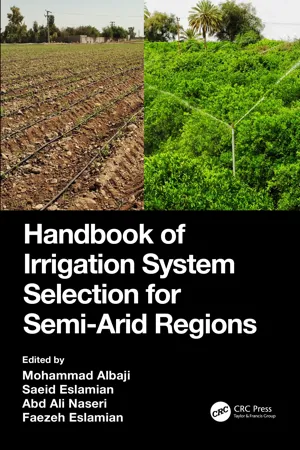
Handbook of Irrigation System Selection for Semi-Arid Regions
- 324 pages
- English
- ePUB (mobile friendly)
- Available on iOS & Android
Handbook of Irrigation System Selection for Semi-Arid Regions
About This Book
The Handbook of Irrigation System Selection for Semi-Arid Regions compares the various types of available irrigation systems for different regions and conditions, and explains how to analyze field data to determine the suitability of the land for surface, sprinkle, or drip irrigation systems. The book focuses on strategies for irrigation development and management and examines deficit irrigation and partial root-zone drying systems. Also, solute leaching modeling under different irrigation systems, soil moisture conditions, and organic fertilizer application in arid areas are discussed. Further, it examines multi-criteria decision making for irrigation management and the appraisal of agricultural lands for irrigation in hot, sub-humid regions.
Features:
-
- Presents comparative analysis to aid in the selection of the most appropriate types of irrigation systems according to land characteristics.
-
- Includes numerous practical case studies.
-
- Offers parametric evaluation systems for irrigation purposes.
-
- Considers data from semi-arid zones, each with different sub-climates.
Focusing on semi-arid land, the book highlights parametric evaluation systems for irrigation purposes, along with the use of analytical hierarchy processes integrated with GIS to determine which systems are best suited. This comprehensive and well-illustrated handbook will be of great interest to students, professionals, and researchers involved with all aspects of irrigation in semi-arid regions.
Frequently asked questions
Information
Section IV
Case Studies
Irrigation System Selection in Western Asia
11 | Appropriate Evaluation of Soils Delta of the Wadi Horan within the Province of Upper Euphrates, Iraq for Some Technologies of Irrigation SystemsAbdulKarem Ahmed Al-Alwany, Farhan J. Mohamed Althyby, and Adel K. Salemn |
11.1 INTRODUCTION
Table of contents
- Cover
- Half Title
- Title Page
- Copyright Page
- Table of Contents
- Preface
- Editors
- Contributors
- SECTION I Introduction
- SECTION II Strategies for Irrigation Development and Management
- SECTION III Case Studies: Irrigation Method Selection for the Crossroads of Central and Southeast Europe and South Asia
- SECTION IV Case Studies: Irrigation System Selection in Western Asia
- Index